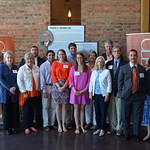Washington serves as classroom for economics students
What better way to grasp an understanding of economic policy than to rub shoulders with those who influence it at the highest levels of government? That was the mindset of the family of the late John Harris ’74 when they created an endowment that allows for senior economics majors to visit economic policymakers in Washington, D.C., each spring.
Fourteen College of Business students from the John E. Walker Department of Economics recently returned from the nation’s capital, where they met with high-level economists in government and think tanks as part of the Senior Seminar in Economics.
“The course is built around policy discussions and the economic policies of the current administration,” said Raymond “Skip” Sauer, an economics professor who accompanied students on the trip. “Students spent two days in Washington and met with some very influential policymakers, including some Clemson alums.”
Students met and asked questions of Mark Calabria, chief economist for Vice President Mike Pence in the Eisenhower Executive Office Building adjacent to the White House. In addition, the students visited the Federal Communications Commission where they met Craig Stroup, a senior economist at the FCC and a ’96 Ph.D. graduate of Clemson.

Lani Czarniecki, deputy assistant to the vice president for external affairs, gave Clemson economics students lessons on the VP’s flag and other historical artifacts.
David Spearman said the trip to Washington gave him better insights into the day-to-day responsibilities of an economist. “You learn so much in class, but it’s not obvious what it’s going to look like when you apply it in a real-world setting,” he said. “It was also helpful getting advice from people working in the profession’s highest levels about things like what hard and soft skills they found beneficial in helping them succeed.”
The group also visited the Brookings Institution and had a meeting with Will Ensor ’15 who studied economics at Clemson and is a research assistant at the American Enterprise Institute think tank. While at AEI, students attended a discussion, “Improving Economic Opportunity in America,” featuring renowned Stanford University economist Raj Chetty and Jason Furman, chair of the Council of Economic Advisors in the Obama administration.
“It’s fitting that the endowment John Harris’ family created would provide Clemson students with such a rich learning opportunity,” Sauer said. “John began his career in Washington as an analyst with the Overseas Private Investment Corporation, a self-sustaining government agency that helps American businesses invest in emerging markets. He subsequently became deeply involved in South Carolina real estate investment and management. His own experience helped him perceive the opportunity for students to visit Washington and engage in policy discussions as a potential game-changer for their careers. This gift to generations of students is a great tribute to him and a life filled with major achievements.”







